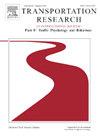What’s your type? A taxonomy of pedestrian route choice behaviour in cities
IF 3.5
2区 工程技术
Q1 PSYCHOLOGY, APPLIED
Transportation Research Part F-Traffic Psychology and Behaviour
Pub Date : 2025-02-01
DOI:10.1016/j.trf.2025.01.012
引用次数: 0
Abstract
Pedestrian route choice behaviour has captivated academic inquiry for over a century. Its study has shaped urban planning and influenced the design of more sustainable urban spaces and the discourse on just cities. While existing research has primarily examined the influence of configurational factors or urban elements on pedestrian movement, their interplay remains poorly understood. This paper addresses this gap by examining how the configurational properties of the street network and the distribution of urban elements shape pedestrian route choice behaviour. Walking tasks and in-depth interviews were conducted in Poznań (Poland) with 18 participants. The 36 routes and their attributes were tracked using GPS devices, while the interviews provided insights into the participants’ decision-making processes and preferences. The analysis resulted in the definition of a taxonomy of pedestrian types based on their route choice behaviour. These types encompass various preferences and strategies, including prioritising comfort, rational decisions, spontaneity, reliance on landmarks, and environmental cues. Moreover, the analysis revealed variations in route's geometry, length, and predictability across the five types. Overall, our findings emphasise the multifaceted nature of pedestrian behaviour as influenced by a combination of “objective” environmental factors, subjective perceptions, and emergent dynamic factors. Elements like weather, crowds, traffic, noise, seasonality, and time of day emerged as additional but significant determinants of decisions. Finally, while green areas and landmarks did impact route choice behaviour, other more nuanced elements - such as paving patterns, storefronts, or prior experiences and memories - also played a role in shaping the participants’ routes, adding further uncertainty around pedestrian behavioural patterns.
求助全文
约1分钟内获得全文
求助全文
来源期刊
CiteScore
7.60
自引率
14.60%
发文量
239
审稿时长
71 days
期刊介绍:
Transportation Research Part F: Traffic Psychology and Behaviour focuses on the behavioural and psychological aspects of traffic and transport. The aim of the journal is to enhance theory development, improve the quality of empirical studies and to stimulate the application of research findings in practice. TRF provides a focus and a means of communication for the considerable amount of research activities that are now being carried out in this field. The journal provides a forum for transportation researchers, psychologists, ergonomists, engineers and policy-makers with an interest in traffic and transport psychology.

 求助内容:
求助内容: 应助结果提醒方式:
应助结果提醒方式:


